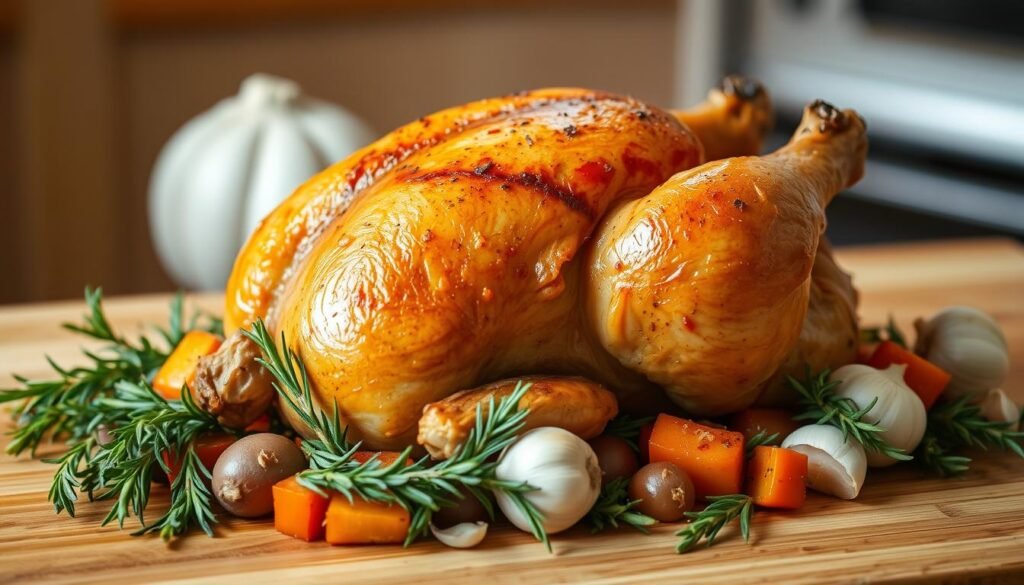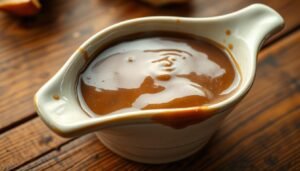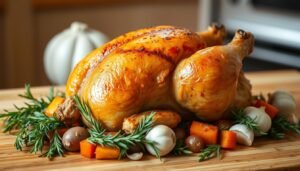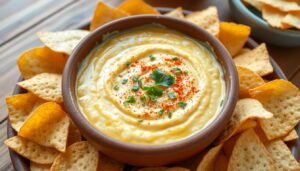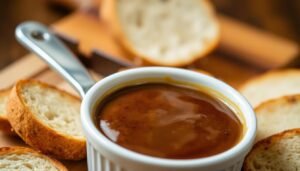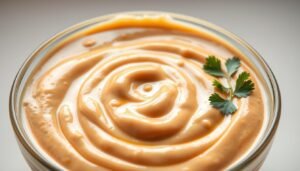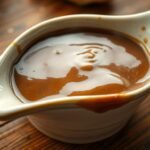Did you know a perfectly cooked Cornish Hen can be the star of a memorable meal? Its tender meat and rich flavor make it a hit with guests. I’ve spent years honing my Cornish Hen recipe, and I’m eager to share it with you.
Cooking a Cornish Hen to perfection needs some skill, but with the right methods, you’ll get juicy and flavorful results every time. In this article, I’ll show you my top Cornish Hen cooking methods. I’ll also share tips on how to season and cook your hen just right.
Key Takeaways
- Learn how to cook a Cornish Hen to perfection using simple techniques.
- Discover the best methods for seasoning your Cornish Hen.
- Understand the importance of proper cooking temperature for tender results.
- Explore different Cornish Hen cooking methods to suit your taste.
- Get tips on presenting your dish for a memorable dining experience.
What is a Cornish Hen?
A Cornish Hen is more than a small chicken. It has a rich history and lots of nutritional value. It’s a young chicken, under 5 weeks old, weighing 1 to 2 pounds. This young age makes the meat tender and juicy.
Origin and History of Cornish Hens
The Cornish Hen doesn’t come from Cornwall, but it’s named after a breed. It’s a young chicken bred for its tender meat. The history of Cornish Hens goes back to the early 20th century in the United States.
The breeding program aimed to create a chicken that was not only flavorful but also had a compact size, making it ideal for single servings. This made Cornish Hens a favorite for special occasions and fine dining.
Nutritional Benefits of Cornish Hens
Cornish Hens are not just tasty, but also full of nutrients. They are a great source of protein, vitamins, and minerals. Here’s a look at their nutritional benefits:
| Nutrient | Amount per serving | % Daily Value |
|---|---|---|
| Protein | 20 grams | 40% |
| Vitamin B6 | 0.3 mg | 15% |
| Niacin | 4.5 mg | 22% |
The nutritional profile of Cornish Hens makes them a healthy choice for those looking for a balanced diet. They are low in fat, even when cooked without the skin. They are also rich in essential nutrients.
Ingredients You Will Need
A perfectly cooked Cornish Hen starts with the right ingredients. To get a tender, juicy, and seasoned dish, focus on a few key components.
Fresh Cornish Hens
The star of the dish is the Cornish Hen. Look for birds that are plump and have a good weight. Check the packaging for damage or leakage. Buy from a reputable butcher or supermarket for freshness.
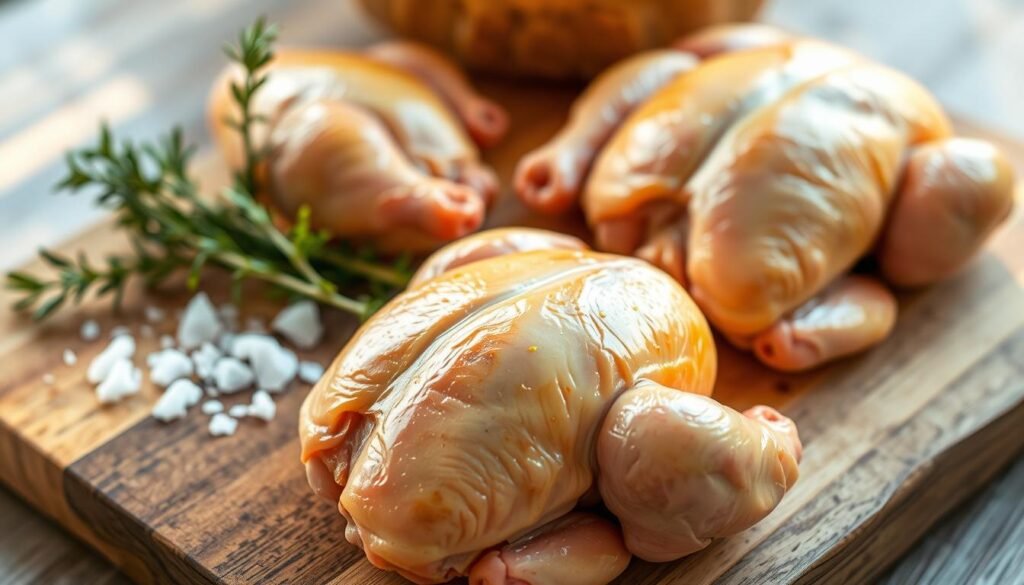
Seasoning Options
Seasoning lets you get creative with your Cornish Hen. Use a mix of salt, pepper, garlic powder, and paprika. You can also add herbs like thyme, rosemary, or sage. For a deeper flavor, try a marinade or a dry rub with spices.
“The right seasoning can elevate your Cornish Hen from good to great.”
Optional Side Dishes
While your Cornish Hen is the main dish, think about side dishes too. Good options include roasted vegetables, mashed potatoes, or a fresh salad. The goal is to balance flavors and textures for a complete meal.
| Side Dish | Description |
|---|---|
| Roasted Vegetables | Brussels sprouts or carrots tossed with olive oil, salt, and pepper, then roasted to perfection. |
| Mashed Potatoes | Creamy mashed potatoes infused with garlic and herbs. |
| Fresh Salad | A mix of fresh greens, cherry tomatoes, and a light vinaigrette. |
By choosing your ingredients and side dishes wisely, you’ll make a delicious and memorable Cornish Hen meal.
Preparing Your Cornish Hen
Before we cook our Cornish Hen, we need to prepare it right. This includes several key steps. They help make the dish tender, juicy, and full of flavor.
Cleaning and Preparing the Hen
The first step is to clean the hen well. Rinse it under cold water and dry it with paper towels. Take out any giblets and neck from inside. It’s important to handle the hen safely to avoid contamination.
Next, prepare the hen for cooking. You might truss it with kitchen twine for even cooking. Trussing also makes the hen look better.
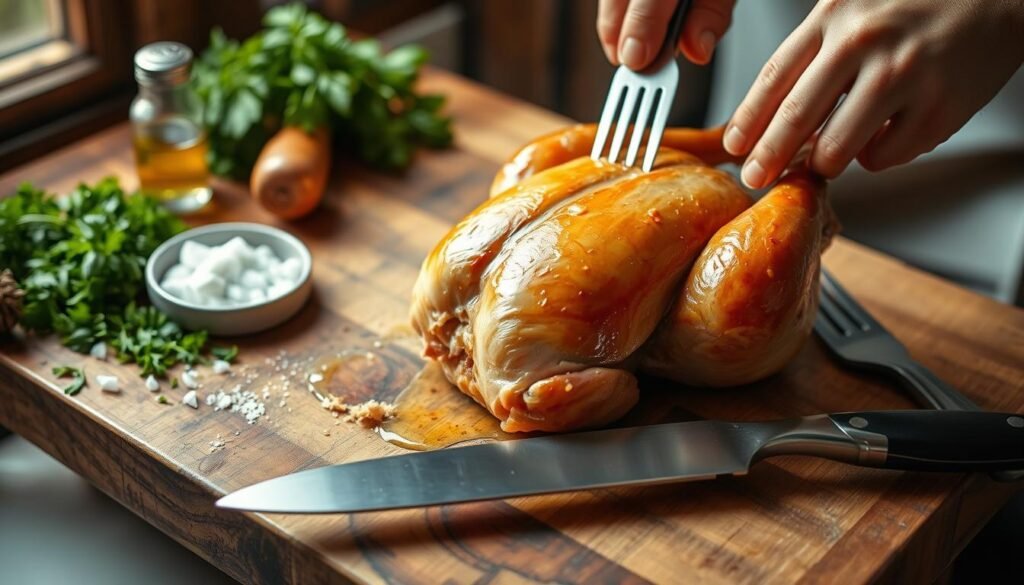
Marinating Techniques
Marinating adds extra flavor to your Cornish Hen. You can use simple marinades or more complex ones. Try olive oil, lemon juice, and herbs, or yogurt and spices.
To marinate, put the hen in a large zip-top bag or a non-reactive container. Pour the marinade over it, making sure it’s coated evenly. Seal the bag or cover the container. Then, refrigerate for at least 2 hours or overnight.
“Marinating not only adds flavor but also helps to tenderize the meat, making it more enjoyable to eat.”
Stuffing Ideas
Stuffing your Cornish Hen adds more flavor. You can use vegetables, herbs, and grains. Try sautéed onions, carrots, and celery, or wild rice and mushrooms.
When stuffing, fill the cavity loosely. Overstuffing can cause uneven cooking and safety issues.
| Stuffing Ingredient | Benefits |
|---|---|
| Aromatic Vegetables | Add depth of flavor |
| Herbs | Provide fresh flavor |
| Grains | Add texture and complexity |
By following these steps and ideas, you can make a delicious and memorable Cornish Hen. It will surely impress your guests.
Cooking Methods for Cornish Hens
To cook a Cornish Hen perfectly, you need to know the different methods. Each method has its own way to make this dish delicious, fitting different tastes.
Roasting in the Oven
Roasting a Cornish Hen in the oven makes it tender and juicy. First, heat your oven to 425°F (220°C). Then, season the hen and put it in a roasting pan. Cook for 45-50 minutes, or until it’s 165°F (74°C) inside.
Tips for Roasting: Dry the hen before seasoning for better browning. Stuffing it with lemon and herbs adds flavor.
Grilling Outdoors
Grilling a Cornish Hen outdoors gives it a smoky taste. Preheat your grill to medium-high. Season the hen and grill for 20-25 minutes per side, until it’s 165°F (74°C) inside.
Grilling Tips: Oil the grates to prevent sticking. Marinating the hen before grilling adds more flavor.
Slow Cooking Options
Slow cooking a Cornish Hen is great for those who like easy cooking. Put the seasoned hen in a slow cooker. Cook on low for 6-8 hours or high for 3-4 hours. It’s done when it’s 165°F (74°C) inside.
Slow Cooking Benefits: This method makes the hen tender and easy to pull apart. It’s perfect for busy days or when you want a meal ready when you get home.
Seasoning Your Cornish Hen
The right seasoning can turn your Cornish Hen into a true masterpiece. There are countless options, and the goal is to find the perfect mix of flavors. This mix should enhance the hen’s natural taste.
Herb and Spice Combinations
Herbs and spices can add depth and complexity to your Cornish Hen. Here are some top picks:
- Classic Blend: Salt, pepper, thyme, and rosemary create a timeless taste.
- Spicy Kick: Paprika, garlic powder, and cayenne pepper add a spicy touch.
- Herb de Provence: Lavender, chamomile, and thyme give a unique, aromatic flavor.
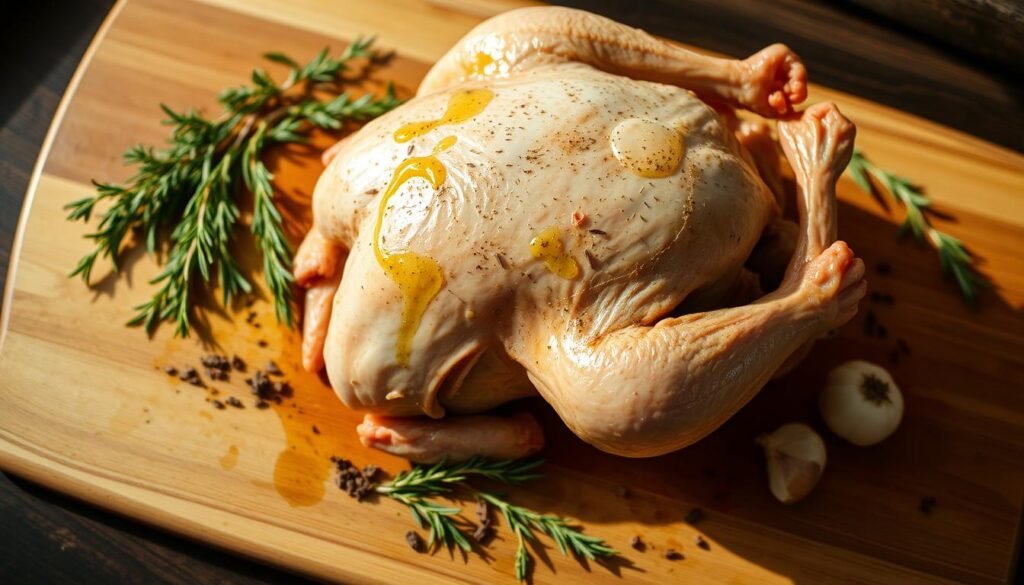
Marinades for Extra Flavor
Marinating your Cornish Hen is a great way to add flavor. A good marinade tenderizes the meat and adds layers of taste. Here are some marinade ideas:
- Lemon and Garlic: Lemon juice, minced garlic, and olive oil create a bright, savory marinade.
- Soy Sauce and Ginger: Soy sauce, grated ginger, and honey make a sweet, savory marinade.
- Yogurt and Spice: Yogurt, cumin, coriander, and cinnamon result in a creamy, aromatic marinade.
Try different herb and spice mixes and marinades to find the perfect seasoning for your Cornish Hen. This will match your taste preferences.
Cooking Times and Tempting Tips
Cooking a Cornish Hen can be a fun experience. It’s all about timing and temperature control. Getting the doneness just right is key.
How to Determine Doneness
To check if your Cornish Hen is done, look at the internal temperature and the color of the juices. The temperature should hit 165°F (74°C). Use a meat thermometer in the thickest part of the breast or thigh, away from bones.
Another way is to cut between the leg and thigh. If the juices are clear, it’s done. If you’re still not sure, the meat should feel firm to the touch.
| Cooking Method | Temperature | Cooking Time |
|---|---|---|
| Roasting | 425°F (220°C) | 45-50 minutes |
| Grilling | Medium-High Heat | 20-25 minutes per side |
| Slow Cooking | 275°F (135°C) | 4-5 hours |
Avoiding Dryness in Cooking
To keep your Cornish Hen moist, don’t overcook it. Brining or marinating before cooking helps a lot. Also, basting with melted butter or olive oil keeps it juicy.
Brining means soaking the hen in saltwater before cooking. It keeps moisture in. Marinating uses oil, acid, and spices to add flavor and keep the meat moist.
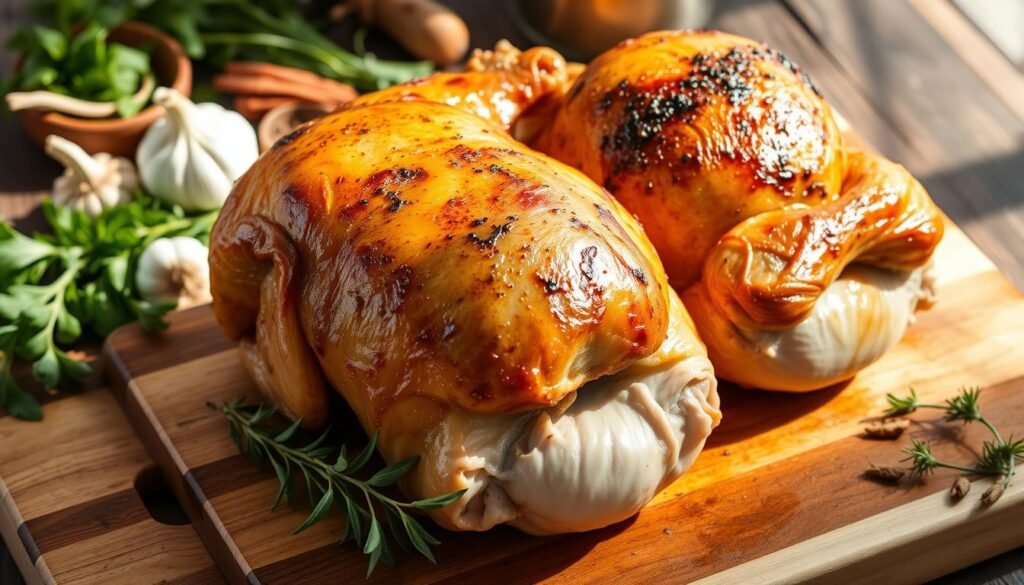
By using these tips, your Cornish Hen will be delicious, moist, and perfectly cooked.
Perfect Pairings: Side Dishes
A good side dish can make your Cornish Hen dinner unforgettable. The right sides can boost the flavors and textures of the main dish. This makes for a balanced and enjoyable meal.
Think about the flavors and textures you want for your Cornish Hen dinner. You can go for classic pairings or try something new. This way, you can find the perfect match for your taste.
Recommended Vegetable Sides
Vegetable sides add color, nutrients, and variety to your meal. Here are some great options:
- Roasted Brussels sprouts with a drizzle of balsamic glaze
- Sautéed spinach with garlic and lemon
- Grilled asparagus with a sprinkle of parmesan cheese
- Roasted carrots with a hint of cumin and coriander
These sides not only go well with Cornish Hen but also offer a refreshing contrast to its rich taste.
Complementary Starches
Starches are key in many meals, offering a satisfying base that pairs well with Cornish Hen. Here are some popular starch options:
| Starch | Description | Pairing Tip |
|---|---|---|
| Mashed Potatoes | Creamy and comforting | Pair with a herb-crusted Cornish Hen |
| Rice Pilaf | Flavorful and aromatic | Complement with a citrus-marinated Cornish Hen |
| Quinoa Salad | Nutritious and versatile | Mix with roasted vegetables and a zesty dressing |
These starches provide a filling and flavorful base that goes well with Cornish Hen.
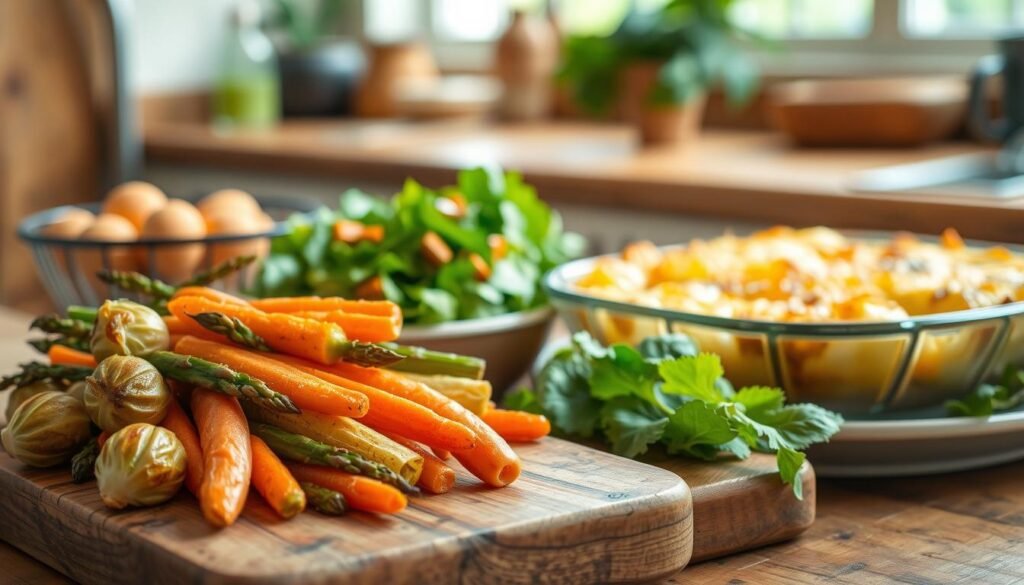
Choosing the right side dishes can make your meal complete and memorable. It will impress and satisfy your guests.
Serving Suggestions for Cornish Hen
Make your meal special with creative ways to serve Cornish Hen. How you present your dish can really make it better. It will make your meal more fun for you and your guests.
Plating Ideas to Impress Guests
Think about placing your Cornish Hen on a platter with roasted veggies and a bit of pan juice. It looks great and tastes even better. For a fancy touch, stuff the hen with herbs and lemon slices before you serve it. This adds color and a nice smell to your plate.
Try serving the hen on a bed of wild rice or quinoa with spinach and cherry tomatoes. It makes the dish look and feel better. For more ideas, check out creative recipes that go well with Cornish Hen.
Garnishing Tips for Presentation
Garnishes can really make your Cornish Hen look amazing. Use fresh herbs like parsley, thyme, or rosemary for a fancy touch. You can also add lemon wedges or orange slices for color and a bit of citrus flavor.
For a bold look, arrange your garnishes in a pattern around the hen. Try using paprika or pomegranate seeds for color. Keep your garnish simple but striking, so the hen is the main attraction.
Leftovers: Creative Ways to Use Cornish Hen
Leftover Cornish Hen can be super versatile. I’m excited to share some ideas with you. Instead of reheating the same meal, you can turn it into new dishes that taste great.
One easy way to use leftover Cornish Hen is in a salad. Shred or chop the meat and mix it with greens, veggies, and dressing. Here are some Cornish Hen salad recipes:
- Classic Cornish Hen Caesar: Toss shredded Cornish Hen with romaine lettuce, croutons, and a tangy Caesar dressing.
- Asian-Style Cornish Hen Salad: Combine chopped Cornish Hen with mixed greens, sliced almonds, and a zesty ginger dressing.
- Mediterranean Cornish Hen Salad: Mix Cornish Hen with chopped cucumbers, cherry tomatoes, feta cheese, and a refreshing lemon-tahini dressing.
Recipes for Cornish Hen Salad
Creating a Cornish Hen salad is all about balancing flavors and textures. Add nuts or seeds for crunch, dried fruits for sweetness, and various cheeses for richness. Try different dressings to find the perfect match for your Cornish Hen.
Making Cornish Hen Soup
Another great way to use leftover Cornish Hen is in a comforting soup. Use the leftover bones and meat to make a rich broth. Just simmer the bones in water or stock, then strain and add your favorite veggies and noodles.
Here are some tips for making Cornish Hen soup:
- Use a mix of veggies like carrots, celery, and onions to deepen your broth.
- Add noodles or rice to make the soup more filling.
- Try different spices and herbs to customize the flavor.
By getting creative with leftovers, you can enjoy a second meal that’s just as good as the first. Whether it’s a salad or soup, your leftover Cornish Hen will become a new favorite.
Common Mistakes to Avoid
Cooking a Cornish Hen is more than just following a recipe. It’s about avoiding common mistakes. To cook it perfectly, you need to watch out for pitfalls during preparation and cooking.
Overcooking or Undercooking
One big mistake is overcooking or undercooking the hen. Overcooking makes the meat dry and tough. Undercooking can be unsafe. To avoid these issues, use a meat thermometer to check the hen’s internal temperature.
The temperature should be 165°F (74°C). Experts say, “A thermometer removes the guesswork from cooking poultry.”
“The key to cooking a perfect Cornish Hen is to not overcook it. The meat should be juicy and tender.”
Here’s a simple table to show the importance of cooking times:
| Cooking Method | Recommended Time | Internal Temperature |
|---|---|---|
| Roasting | 45-50 minutes | 165°F (74°C) |
| Grilling | 20-25 minutes per side | 165°F (74°C) |
| Slow Cooking | 4-6 hours on low | 165°F (74°C) |
Skipping Essential Seasoning Steps
Another mistake is skipping seasoning steps. Seasoning is key to enhancing the hen’s flavors. As discussed on similar cooking mistakes, good seasoning makes a big difference.
Don’t be shy with herbs and spices. A mix of salt, pepper, garlic powder, and paprika can add great flavor. Marinating the hen before cooking also boosts the taste. Let it marinate for at least a few hours or overnight for the best flavor.
Conclusion: Enjoying Your Cornish Hen Recipe
Cooking a Cornish Hen recipe is a fun experience that brings people together. As you enjoy the tender meat and flavors, you’ll see why it’s great for celebrations. It’s perfect for sharing with friends and family.
Sharing the Joy
Whether it’s a dinner party or a cozy night at home, a well-cooked Cornish Hen will wow everyone. The joy of sharing a meal with loved ones is what makes cooking so rewarding. Remember, the experience of enjoying your Cornish Hen is just as important as the food itself.
Continuing the Culinary Journey
Now that you know how to cook Cornish Hen, it’s time to try new recipes and techniques. Experiment with different seasonings, marinades, and cooking methods. With each new dish, you’ll grow more confident in the kitchen and create memorable meals for those you care about.

